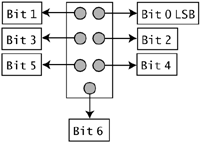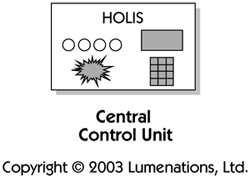This use case prescribes the way in which lights are turned on and off and also how they are dimmed and brightened in accordance with how long the user presses a button on the Control Switch.
Basic flow begins when the Resident presses the On/Off/Dim button on the Control Switch. When the Resident removes pressure on the On/Off/Dim button within the timer period, the system "toggles" the state of the light as follows .
End of basic flow.
When the Resident holds down the On/Off/Dim button for more than 1 second, the system initiates a brightening/ dimming activity for the room's Light Bank.
On leaving this use case, the system remembers the current brightness level for the selected On/Off/Dim button.
None.
For brevity, we present excerpts from the HOLIS supplementary specification here. Appendix D in this book contains a generic, annotated supplementary specification template you might wish to adopt.
1 Introduction
1.1 Purpose
This is the supplementary specification for the v1.0 release of the HOLIS Central Control Unit (CCU) subsystem.
1.2 Scope
This specification is for the CCU only
1.3 References
-
HOLIS Vision Document
-
HOLIS System Level Hardware Specification
-
HOLIS System-Level Use-Case Model
-
HOLIS Control Switch Use-Case Model and Supplementary Specification
-
HOLIS PC Programmer Use-Case Model and Supplementary Specification
1.4 Assumptions and Dependencies
2 Functionality
SR1. OnLevel illumination parameter. Each controlled lighting bank that is Dim Enabled is controlled by the parameter OnLevel, which controls the percent of illumination to the light. The nine possible OnLevel settings are 10%, 20%, 30%, 40%, 50%, 60%, 70%, 80%, and 90%.
SR2. The system supports up to 255 event-time schedules. The allowable programming precision of an event-time schedule shall be 1 minute.
SR3. Event-time schedules can be programmed on either a 12-hour or a 24- hour clock. The user shall enter the data in the following format:
Event number (1256), Time of day (in 24-hour HH:MM format)
SR4. Message protocol from Control Switch. Each button press on the control initiates a single 4-byte message to the CCU. The message protocol is as follows.
| Address of sending device | Message number | Data | Checksum |
The data fields in the message are mapped as follows.
SR4.1. Address 0 “254, the logical address of the specific control switch sending the message
SR4.2. Message Number 0 “255. Message numbers supported are
-
Normal key press
-
Emergency
-
Held down for the last 0.5 second
SR4.3.  Data , each bit corresponding to a specific button on the key switch.
Data , each bit corresponding to a specific button on the key switch.
SR4.4. Message Acknowledgment. In reply to the message from the Control Switch, the CCU shall respond with the following message.
| [55] | [FF] | Received data | Checksum |
where 55 (hex) is the dedicated address of the CCU, FF (hex) is the Acknowledge Message code, Received data returns the data byte received from the CCU, and Checksum is the calculated checksum for the returned message.
3 Usability
4 Reliability
SR9. System availability must be greater than or equal to 99.99%.
SR10. The CCU shall have no defects that can interfere with normal operation of the homeowner 's residence.
5 Performance
SR11. HOLIS shall execute event-time schedules with an accuracy of 1 minute ±5 seconds as measured by the system clock.
6 Supportability
7 Design Constraints
DC1. Control subsystem design is based on the controller module from the ALSP product line. BIOS should not be modified unless absolutely necessary.
DC2. The use case and supporting infrastructure for the emergency sequence must be validated to the highest reasonable commercial reliability standards.
8 Documentation Requirements
SR27. HOLIS ships with a Product Guide. The Product Guide contains all application guides, process guides, installation guides, tutorials, and glossary. The Product Guide is created as an HTML online guide. All applications needing to reference help link to the Product Guide. Microsoft Word copies of each of the guide sections are also shipped with the product.
SR29. The Installation Guide found in the Product Guide is also printed and shipped with the CD-ROM.
9 Purchased Components
10 Interfaces
10.1 User Interfaces
10.2 Hardware Interfaces
10.3 Software Interfaces
10.4 Communications Interfaces
11 Licensing, Security, and Installation Requirements
11.1 CCU Licensing Requirements
SR53. CCU software is factory installed and there are no user licensing or installation requirements.
11.2 Sublicensing Requirements
SR54. The Datamatch Java Library from the Oxford Foundation is incorporated in the application. The end user documentation included with the redistribution must include the following acknowledgment.
This product includes software developed by the Oxford Software Foundation ( http://www.Oxfordxfound.org/ ).
Alternately, this acknowledgment may appear in the software itself, if and wherever such third-party acknowledgments normally appear.
12 Legal, Copyright, and Other Notices
SR72. All code, product documents, online help, user interfaces, and About dialogs must contain the following copyright message.
Copyright 2003-2004 Lumenations, Ltd. All rights reserved.
SR75. Flash the standard corporate copyright notice, corporate logo, and HOLIS product logo for a minimum of 5 seconds during startup mode.
SR76. In idle mode, (when no programming is active), the display shall show the HOLIS logo.
13 Applicable Standards
14 Internationalization and Localization
SR89. All data processing components support UTF-8 character encoding.
SR90. All output text files must be ISO-8859-1 and “2 encoded. This supports all Latin-1 and Cyrillic languages.
SR97. The following are acceptable input content text file encodings: ASCII, Latin-1&2 (ISO-8859-1&2), UTF-8.
15 Physical Deliverables
16 Installation and Deployment
Appendix A Glossary
